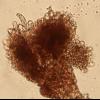
15-05-2017 14:18
Simon KennedyCan any help with the attached. It was growing on

04-04-2017 22:40
 Hans-Otto Baral
Hans-Otto Baral
On the upper side of fallen, decorticated, +/- und

14-05-2017 21:24
HOla, necesito el artículo: ?Z?huang, W. 2000. Hy

14-05-2017 19:36
 Nicolas VAN VOOREN
Nicolas VAN VOOREN
Here is a collection (unfortunately not in a very

14-05-2017 15:40
es madera de abeto, en tronco podrido A ver que

12-05-2017 17:44
This Ophiobolus (¿) species is extremely common o
Hyphomycete on Plagiochila and Literature Request
Simon Kennedy,
15-05-2017 14:18
Ascomycetes and anamorphic fungi growing on Plagiochila (Hepaticae) in Finland Tarja Marsh, Peter Döbbeler, Seppo Huhtinen, Soili Stenroos
Karstenia 50: 59?72.

